Web of Science-Based Green Infrastructure: A Bibliometric Analysis in CiteSpace
Abstract
:1. Introduction
2. Materials and Research Methods
2.1. Data Sources
2.2. Methodology
3. Results
3.1. Trends in Publications by Stage
3.2. Keyword Analysis
3.2.1. Distribution of Publication by Keywords
3.2.2. Timeline Analysis of Keywords
3.2.3. Keyword Bursts
3.3. Distribution of Publications by Journal
3.4. Distribution of Publications by Disciplines
3.5. Distribution of Publications by Country
3.6. Distribution of Publications by Institution
3.7. Distribution of Publications by Author
3.8. Co-Citation Analysis of Literature
4. Discussion
4.1. Advantages of Bibliometric Analysis and CiteSpace
4.2. The Current and Future Trajectory of Green Infrastructure (GI) Research
4.3. Limitations of This Study
5. Conclusions
Author Contributions
Funding
Data Availability Statement
Conflicts of Interest
References
- Venkataramanan, V.; Denise, L.; McCuskey, D.; Kiefus, D.; Mcdonald, R.; Miller, W.; Packman, A.; Young, S. Knowledge, attitudes, intentions, and behavior related to green infrastructure for flood management: A systematic literature review. Sci. Total Environ. 2020, 720, 137606. [Google Scholar] [CrossRef] [PubMed]
- Bartesaghi-Koc, C.; Osmond, P.; Peters, A. Mapping and classifying green infrastructure typologies for climate-related studies based on remote sensing data. Urban For. Urban Green. 2019, 37, 154–167. [Google Scholar] [CrossRef]
- Rajoo, K.S.; Karam, D.S.; Abdullah, M.Z. The physiological and psychosocial effects of forest therapy: A systematic review. Urban For. Urban Green. 2020, 54, 126744. [Google Scholar] [CrossRef]
- Artmann, M.; Kohler, M.; Meinel, G.; Gan, J.; Ioja, I.-C. How smart growth and green infrastructure can mutually support each other—A conceptual framework for compact and green cities. Ecol. Indic. 2019, 96, 10–22. [Google Scholar] [CrossRef]
- Abhijith, K.; Kumar, P.; Gallagher, J.; McNabola, A.; Baldauf, R.; Pilla, F.; Broderick, B.; DI Sabatino, S.; Pulvirenti, B. Air pollution abatement performances of green infrastructure in open road and built-up street canyon environments—A review. Atmos. Environ. 2017, 162, 71–86. [Google Scholar] [CrossRef]
- Escobedo, F.J.; Giannico, V.; Jim, C.; Sanesi, G.; Lafortezza, R. Urban forests, ecosystem services, green infrastructure and nature-based solutions: Nexus or evolving metaphors? Urban For. Urban Green. 2019, 37, 3–12. [Google Scholar] [CrossRef]
- Voghera, A.; Giudice, B. Evaluating and Planning Green Infrastructure: A Strategic Perspective for Sustainability and Resilience. Sustainability 2019, 11, 2726. [Google Scholar] [CrossRef] [Green Version]
- Pauleit, S.; Ambrose, B.; Endersson, E.; Anton Buijs, A.; Haase, D.; Elands, B.; Hansen, R.; Kowarik, I.; Kronenburg, J.; Mattijssen, T.; et al. Advancing urban green infrastructure in Europe: Outcomes and reflections from the GREEN SURGE project. Urban For. Urban Green. 2019, 40, 4–16. [Google Scholar] [CrossRef]
- Newell, J.; Seymour, M.; Yee, T.; Renteria, J.; Longcore, T.; Wolch, J.R.; Shishkovsky, A. Green Alley Programs: Planning for a sustainable urban infrastructure? Cities 2013, 31, 144–155. [Google Scholar] [CrossRef]
- Thomé, A.M.T.; Ceryno, P.S.; Scavarda, A.; Remmen, A. Sustainable infrastructure: A review and a research agenda. J. Environ. Manag. 2016, 184, 143–156. [Google Scholar] [CrossRef]
- Platt, H.L.; Spirn, A. The Granite Garden: Urban Nature and Human Design. Technol. Cult. 1986, 27, 332. [Google Scholar] [CrossRef]
- Johnson, C.; Tilt, J.H.; Ries, P.D.; Shindler, B. Continuing professional education for green infrastructure: Fostering collaboration through interdisciplinary trainings. Urban For. Urban Green. 2019, 41, 283–291. [Google Scholar] [CrossRef]
- Wang, J.; Banzhaf, E. Towards a better understanding of Green Infrastructure: A critical review. Ecol. Indic. 2018, 85, 758–772. [Google Scholar] [CrossRef]
- What is Green Infrastructure? 2015. Available online: https://www.epa.gov/green-infrastructure/what-green-infrastructure (accessed on 6 July 2016).
- EPA’s 6th Drinking Water Infrastructure Needs Survey and Assessment. Reports and Assessments, U.S. Environmental Protection Agency. 2018. Available online: https://www.epa.gov/drinkingwatersrf/epas-6th-drinking-water-infrastructure-needs-survey-and-assessment (accessed on 30 March 2018).
- Meng, T.; Hsu, D. Stated preferences for smart green infrastructure in stormwater management. Landsc. Urban Plan. 2019, 187, 1–10. [Google Scholar] [CrossRef]
- Vongpraseuth, T.; Choi, C.G. Globalization, foreign direct investment, and urban growth management: Policies and conflicts in Vientiane, Laos. Land Use Policy 2015, 42, 790–799. [Google Scholar] [CrossRef]
- Chini, C.M.; Canning, J.F.; Schreiber, K.L.; Peschel, J.M.; Stillwell, A.S. The Green Experiment: Cities, Green Stormwater Infrastructure, and Sustainability. Sustainability 2017, 9, 105. [Google Scholar] [CrossRef] [Green Version]
- Davies, C.; Lafortezza, R. Urban green infrastructure in Europe: Is greenspace planning and policy compliant? Land Use Policy 2017, 69, 93–101. [Google Scholar] [CrossRef]
- Van Oijstaeijen, W.; Van Passel, S.; Cools, J. Urban green infrastructure: A review on valuation toolkits from an urban planning perspective. J. Environ. Manag. 2020, 267, 110603. [Google Scholar] [CrossRef] [PubMed]
- O’Brien, L.; De Vreese, R.; Kern, M.; Sievänen, T.; Stojanova, B.; Atmiş, E. Cultural ecosystem benefits of urban and peri-urban green infrastructure across different European countries. Urban For. Urban Green. 2017, 24, 236–248. [Google Scholar] [CrossRef]
- Shao, H.; Song, P.; Mu, B.; Tian, G.; Chen, Q.; He, R.; Kim, G. Assessing city-scale green roof development potential using Unmanned Aerial Vehicle (UAV) imagery. Urban For. Urban Green. 2021, 57, 126954. [Google Scholar] [CrossRef]
- Seiwert, A.; Rößler, S. Understanding the term green infrastructure: Origins, rationales, semantic content and purposes as well as its relevance for application in spatial planning. Land Use Policy 2020, 97, 104785. [Google Scholar] [CrossRef]
- Martí, P.; García-Mayor, C.; Nolasco-Cirugeda, A.; Serrano-Estrada, L. Green infrastructure planning: Unveiling meaningful spaces through Foursquare users’ preferences. Land Use Policy 2020, 97, 104641. [Google Scholar] [CrossRef]
- Basnou, C.; Baró, F.; Langemeyer, J.; Castell, C.; Dalmases, C.; Pino, J. Advancing the green infrastructure approach in the Province of Barcelona: Integrating biodiversity, ecosystem functions and services into landscape planning. Urban For. Urban Green. 2020, 55, 126797. [Google Scholar] [CrossRef]
- Miller, S.M.; Montalto, F.A. Stakeholder perceptions of the ecosystem services provided by Green Infrastructure in New York City. Ecosyst. Serv. 2019, 37, 100928. [Google Scholar] [CrossRef]
- Tzoulas, K.; Korpela, K.; Venn, S.; Yli-Pelkonen, V.; Kaźmierczak, A.; Niemela, J.; James, P. Promoting ecosystem and human health in urban areas using Green Infrastructure: A literature review. Landsc. Urban Plan. 2007, 81, 167–178. [Google Scholar] [CrossRef] [Green Version]
- Mekala, G.D.; Jones, R.N.; Macdonald, D.H. Valuing the Benefits of Creek Rehabilitation: Building a Business Case for Public Investments in Urban Green Infrastructure. Environ. Manag. 2015, 55, 1354–1365. [Google Scholar] [CrossRef] [PubMed]
- Parker, J.; Zingoni de Baro, M.E. Green Infrastructure in the Urban Environment: A Systematic Quantitative Review. Sustainability 2019, 11, 3182. [Google Scholar] [CrossRef] [Green Version]
- Zölch, T.; Maderspacher, J.; Wamsler, C.; Pauleit, S. Using green infrastructure for urban climate-proofing: An evaluation of heat mitigation measures at the micro-scale. Urban For. Urban Green. 2016, 20, 305–316. [Google Scholar] [CrossRef]
- Kumar, P.; Druckman, A.; Gallagher, J.; Gatersleben, B.; Allison, S.; Eisenman, T.S.; Hoang, U.; Hama, S.; Tiwari, A.; Sharma, A.; et al. The nexus between air pollution, green infrastructure and human health. Environ. Int. 2019, 133, 105181. [Google Scholar] [CrossRef]
- Junqueira, J.R.; Serrao-Neumann, S.; White, I. A systematic review of approaches for modelling current and future impacts of extreme rainfall events using green infrastructure. J. Clean. Prod. 2021, 290, 125173. [Google Scholar] [CrossRef]
- Zhang, K.; Chui, T.F.M. A comprehensive review of spatial allocation of LID-BMP-GI practices: Strategies and optimization tools. Sci. Total Environ. 2018, 621, 915–929. [Google Scholar] [CrossRef] [PubMed]
- Venter, Z.S.; Krog, N.H.; Barton, D.N. Linking green infrastructure to urban heat and human health risk mitigation in Oslo, Norway. Sci. Total Environ. 2020, 709, 136193. [Google Scholar] [CrossRef]
- Saaroni, H.; Amorim, J.; Hiemstra, J.; Pearlmutter, D. Urban Green Infrastructure as a tool for urban heat mitigation: Survey of research methodologies and findings across different climatic regions. Urban Clim. 2018, 24, 94–110. [Google Scholar] [CrossRef]
- Kavehei, E.; Jenkins, G.; Adame, F.; Lemckert, C. Carbon sequestration potential for mitigating the carbon footprint of green stormwater infrastructure. Renew. Sustain. Energy Rev. 2018, 94, 1179–1191. [Google Scholar] [CrossRef]
- Chen, W.Y. The role of urban green infrastructure in offsetting carbon emissions in 35 major Chinese cities: A nationwide estimate. Cities 2015, 44, 112–120. [Google Scholar] [CrossRef]
- Romero-Duque, L.P.; Trilleras, J.; Castellarini, F.; Quijas, S. Ecosystem services in urban ecological infrastructure of Latin America and the Caribbean: How do they contribute to urban planning? Sci. Total Environ. 2020, 728, 138780. [Google Scholar] [CrossRef] [PubMed]
- Sikorska, D.; Sikorski, P.; Hopkins, R.J. High Biodiversity of Green Infrastructure Does Not Contribute to Recreational Ecosystem Services. Sustainability 2017, 9, 334. [Google Scholar] [CrossRef] [Green Version]
- Shackleton, C.; Blair, A.; De Lacy, P.; Kaoma, H.; Mugwagwa, N.; Dalu, M.T.; Walton, W. How important is green infrastructure in small and medium-sized towns? Lessons from South Africa. Landsc. Urban Plan. 2018, 180, 273–281. [Google Scholar] [CrossRef]
- Kim, G.; Newman, G.; Jiang, B. Urban regeneration: Community engagement process for vacant land in declining cities. Cities 2020, 102, 102730. [Google Scholar] [CrossRef]
- Pakzad, P.; Osmond, P.; Corkery, L. Developing Key Sustainability Indicators for Assessing Green Infrastructure Performance. Procedia Eng. 2017, 180, 146–156. [Google Scholar] [CrossRef]
- Harrington, E.; Hsu, D. Roles for government and other sectors in the governance of green infrastructure in the U.S. Environ. Sci. Policy 2018, 88, 104–115. [Google Scholar] [CrossRef]
- Angelstam, P.; Pedersen, S.; Manton, M.; Garrido, P.; Naumov, V.; Elbakidze, M. Green infrastructure maintenance is more than land cover: Large herbivores limit recruitment of key-stone tree species in Sweden. Landsc. Urban Plan. 2017, 167, 368–377. [Google Scholar] [CrossRef]
- Meerow, S. The politics of multifunctional green infrastructure planning in New York City. Cities 2020, 100, 102621. [Google Scholar] [CrossRef]
- Dhakal, K.P.; Chevalier, L.R. Managing urban stormwater for urban sustainability: Barriers and policy solutions for green infrastructure application. J. Environ. Manag. 2017, 203, 171–181. [Google Scholar] [CrossRef]
- Jerome, G.; Sinnett, D.; Burgess, S.; Calvert, T.; Mortlock, R. A framework for assessing the quality of green infrastructure in the built environment in the UK. Urban For. Urban Green. 2019, 40, 174–182. [Google Scholar] [CrossRef]
- Meng, L.; Wen, K.-H.; Brewin, R.; Wu, Q. Knowledge Atlas on the Relationship between Urban Street Space and Residents’ Health—A Bibliometric Analysis Based on VOSviewer and CiteSpace. Sustainability 2020, 12, 2384. [Google Scholar] [CrossRef] [Green Version]
- Yang, H.; Shao, X.; Wu, M. A Review on Ecosystem Health Research: A Visualization Based on CiteSpace. Sustainability 2019, 11, 4908. [Google Scholar] [CrossRef] [Green Version]
- Chatzimentor, A.; Apostolopoulou, E.; Mazaris, A.D. A review of green infrastructure research in Europe: Challenges and opportunities. Landsc. Urban Plan. 2020, 198, 103775. [Google Scholar] [CrossRef]
- Kim, M.C.; Zhu, Y.; Chen, C. How are they different? A quantitative domain comparison of information visualization and data visualization (2000–2014). Science 2016, 107, 123–165. [Google Scholar] [CrossRef]
- Chen, C. CiteSpace II: Detecting and visualizing emerging trends and transient patterns in scientific literature. J. Am. Soc. Inf. Sci. Technol. 2006, 57, 359–377. [Google Scholar] [CrossRef] [Green Version]
- Chen, C.; Song, M. Visualizing a field of research: A methodology of systematic scientometric reviews. PLoS ONE 2019, 14, e0223994. [Google Scholar] [CrossRef] [PubMed] [Green Version]
- Zhang, Y.; Chen, Y. Research trends and areas of focus on the Chinese Loess Plateau: A bibliometric analysis during 1991–2018. Catena 2020, 194, 104798. [Google Scholar] [CrossRef]
- Zhang, D.; Xu, J.; Zhang, Y.; Wang, J.; He, S.; Zhou, X. Study on sustainable urbanization literature based on Web of Science, scopus, and China national knowledge infrastructure: A scientometric analysis in CiteSpace. J. Clean. Prod. 2020, 264, 121537. [Google Scholar] [CrossRef]
- Retno, D.P.; Wibowo, M.A.; Hatmoko, J.U.D. The Scientometric Approach of Mapping Sustainable Green Infrastructure Research Developments. J. Phys. Conf. Ser. 2020, 1625, 012002. [Google Scholar] [CrossRef]
- Shi, Y.; Liu, X. Research on the Literature of Green Building Based on the Web of Science: A Scientometric Analysis in CiteSpace (2002–2018). Sustainability 2019, 11, 3716. [Google Scholar] [CrossRef] [Green Version]
- Nordman, E.E.; Isely, E.; Isely, P.; Denning, R. Benefit-cost analysis of stormwater green infrastructure practices for Grand Rapids, Michigan, USA. J. Clean. Prod. 2018, 200, 501–510. [Google Scholar] [CrossRef]
- Hou, J.; Yang, X.; Chen, C. Measuring researchers’ potential scholarly impact with structural variations: Four types of researchers in information science (1979–2018). PLoS ONE 2020, 15, e0234347. [Google Scholar] [CrossRef] [PubMed]
- Chen, C. Science Mapping: A Systematic Review of the Literature. J. Data Inf. Sci. 2017, 2, 1–40. [Google Scholar] [CrossRef] [Green Version]
- Ding, W.; Chen, C. Dynamic topic detection and tracking: A comparison of HDP, C-word, and cocitation methods. J. Assoc. Inf. Sci. Technol. 2014, 65, 2084–2097. [Google Scholar] [CrossRef]
- Liu, H.; Chen, H.; Hong, R.; Liu, H.; You, W. Mapping knowledge structure and research trends of emergency evacuation studies. Saf. Sci. 2020, 121, 348–361. [Google Scholar] [CrossRef]
- Chen, C. Visualizing and Exploring Scientific Literature with CiteSpace. In Proceedings of the 23rd International Conference on Intelligent User Interfaces, Tokyo, Japan, 7–11 March 2018; Association for Computing Machinery: New York, NY, USA, 2018; pp. 369–370. [Google Scholar]
- Chen, C.; Chen, Y.; Horowitz, M.; Haiyan, H.; Luan, C.; Pellegrino, D. Towards an explanatory and computational theory of scientific discovery. J. Informetr. 2009, 3, 191–209. [Google Scholar] [CrossRef] [Green Version]
- Ying, J.; Zhang, X.; Zhang, Y.; Bilan, S. Green infrastructure: Systematic literature review. Econ. Res. Ekon. Istraživanja 2021, 35, 1–22. [Google Scholar] [CrossRef]
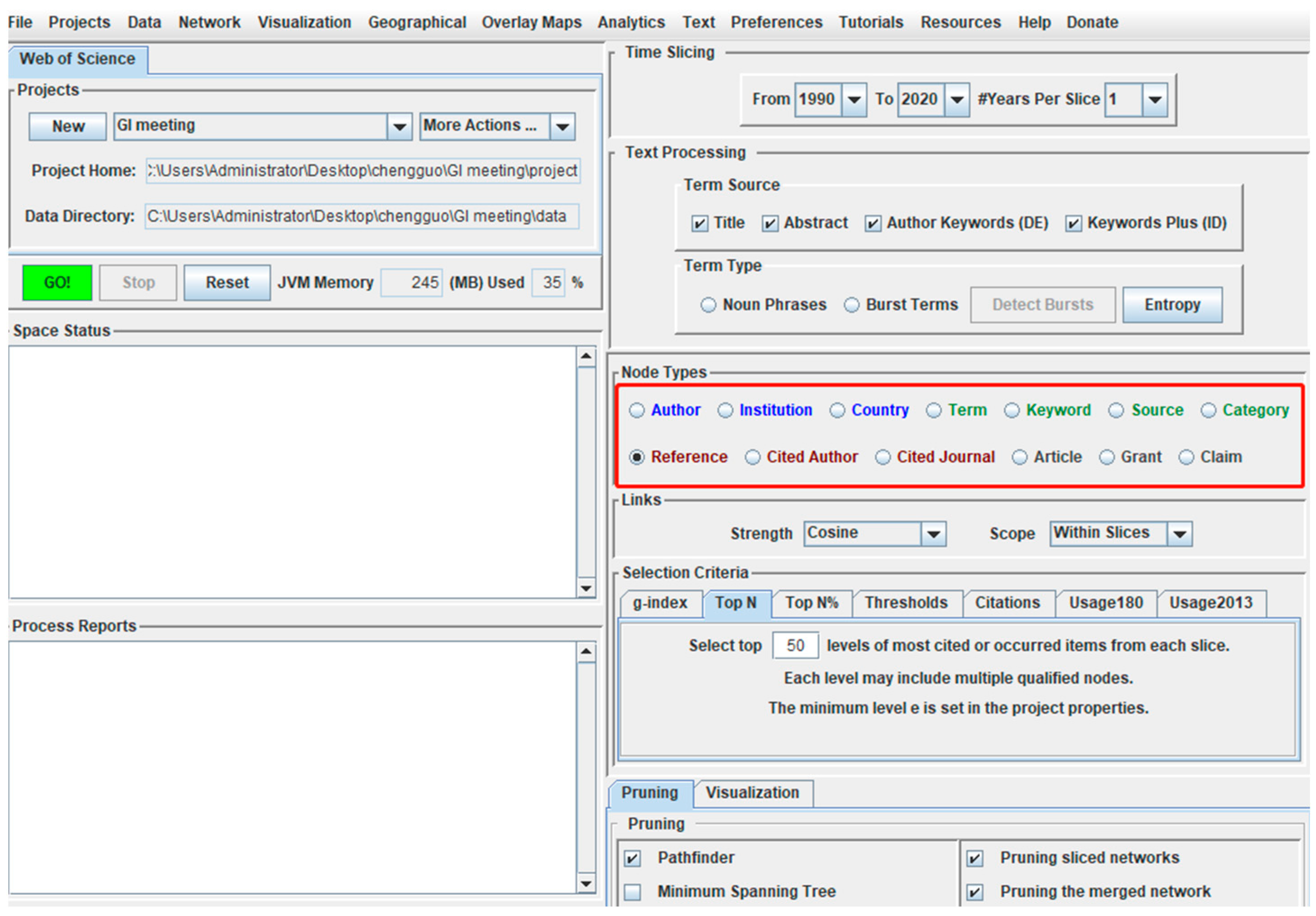
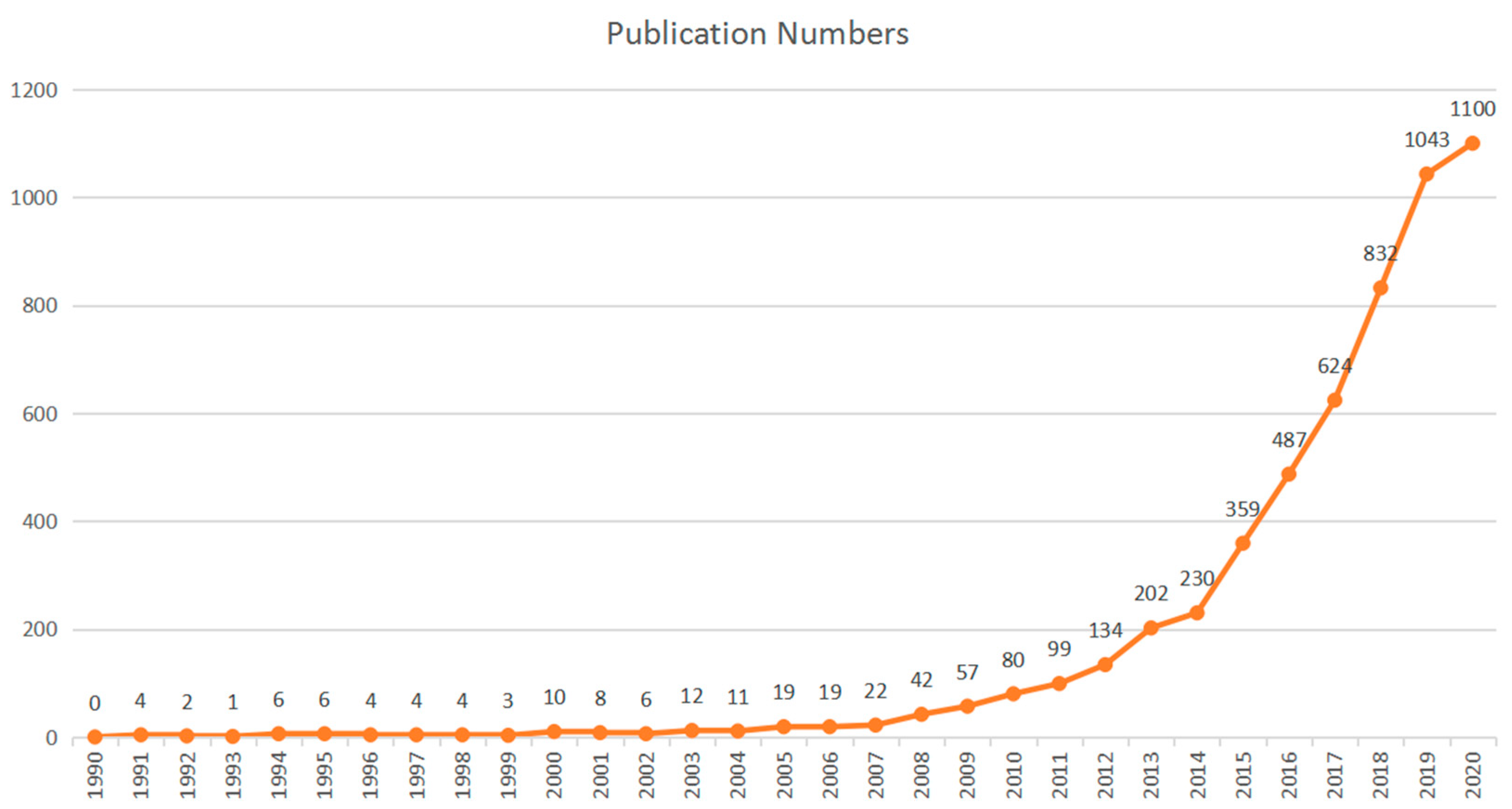
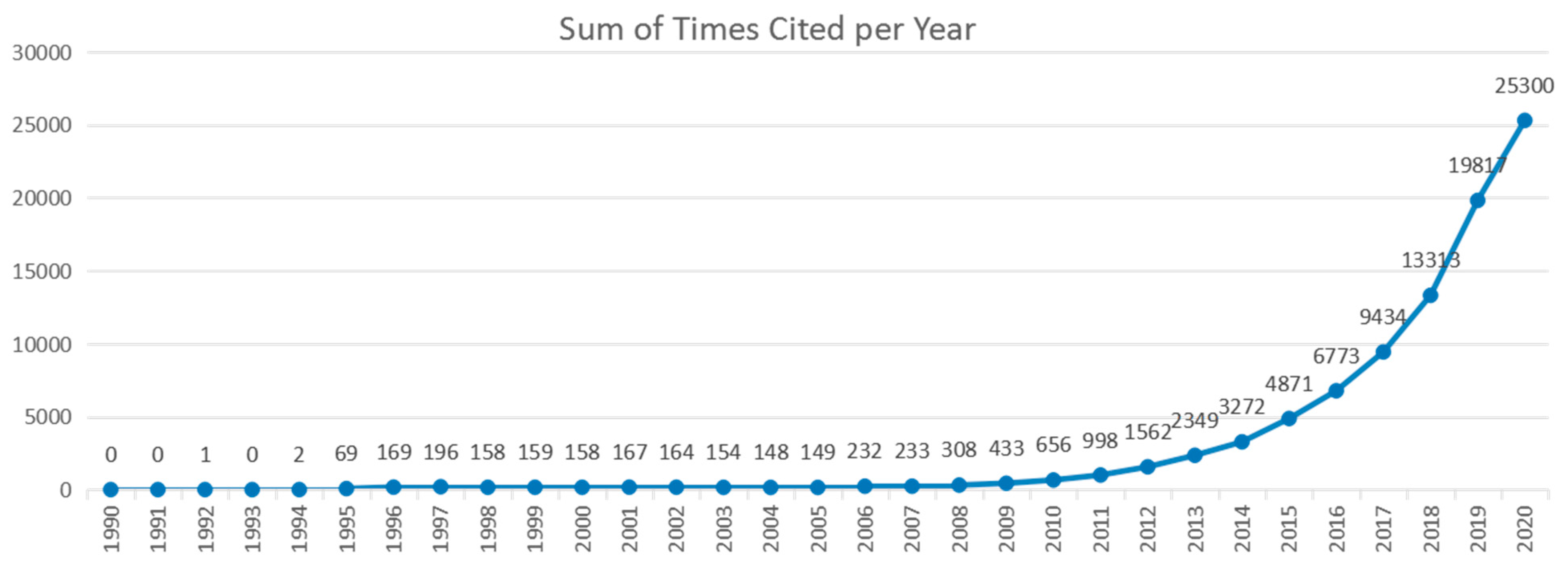
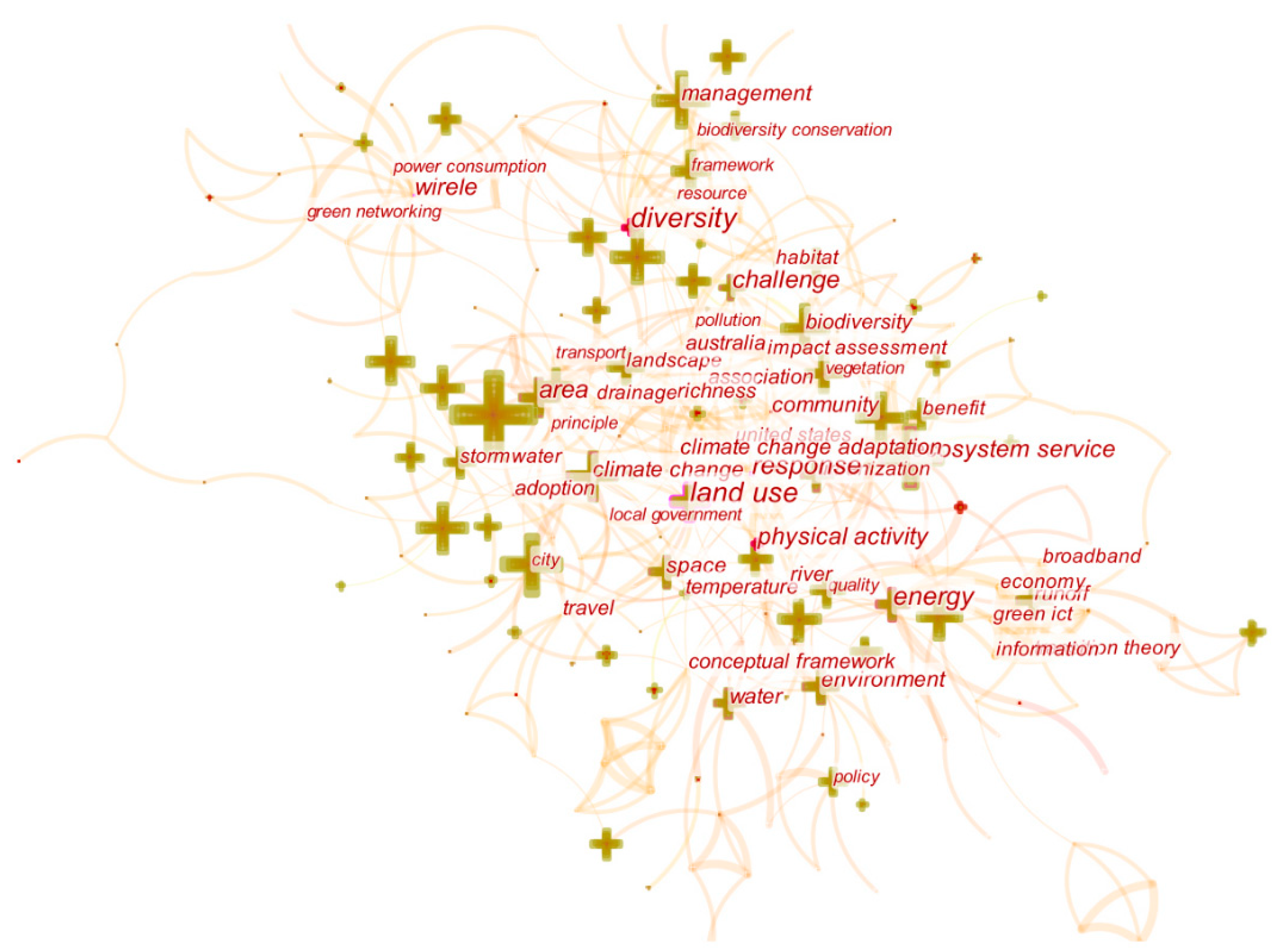
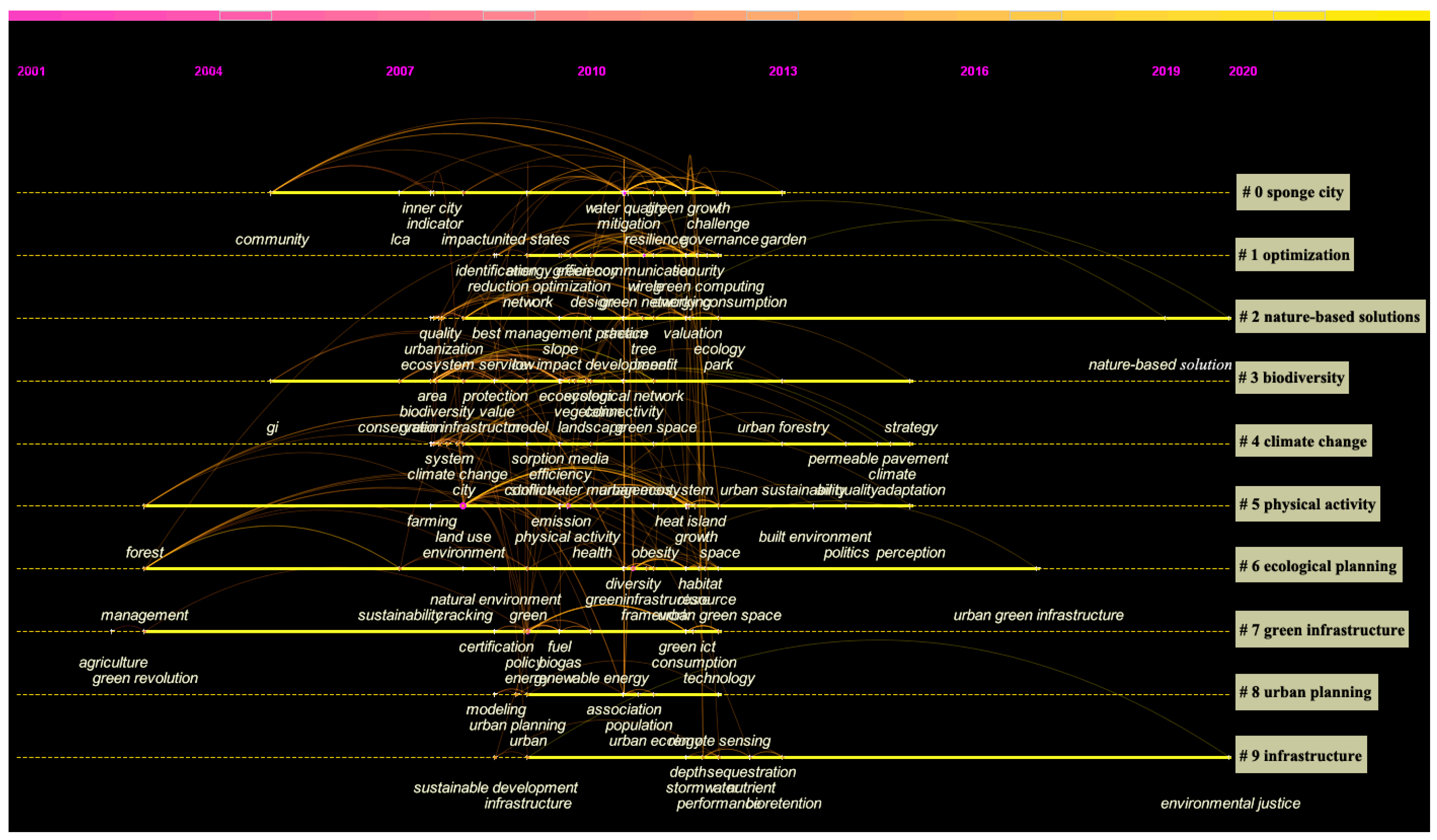

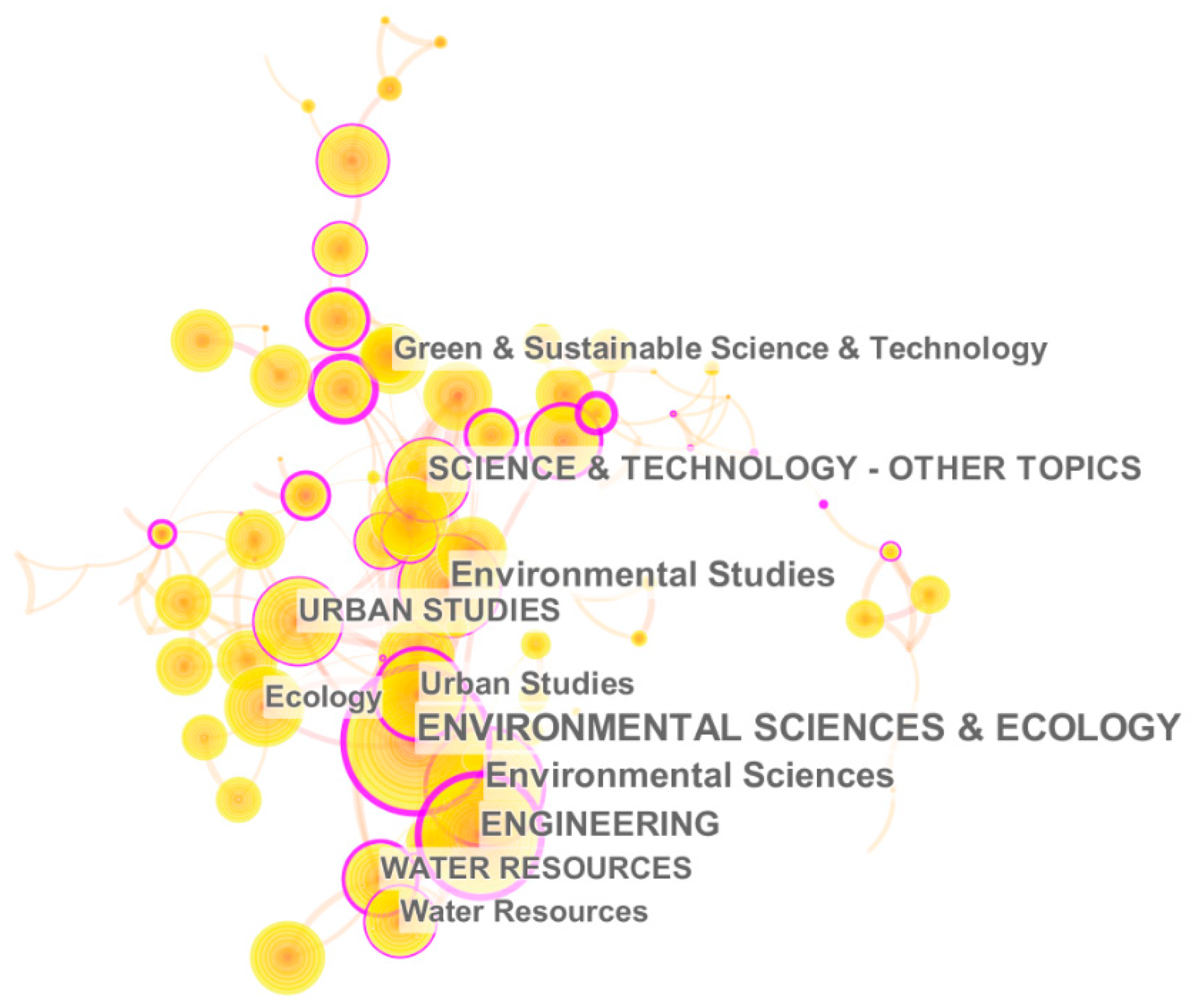
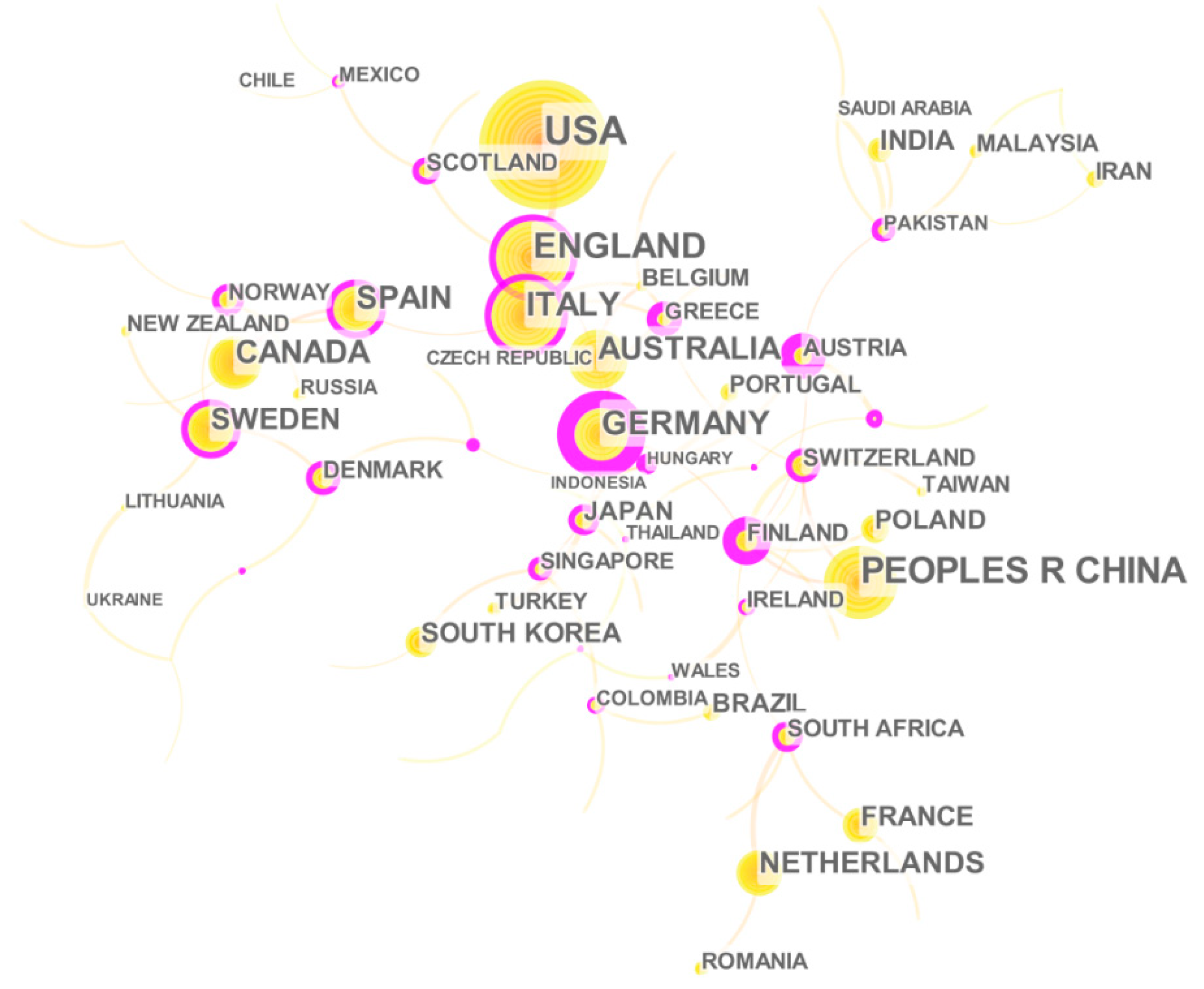
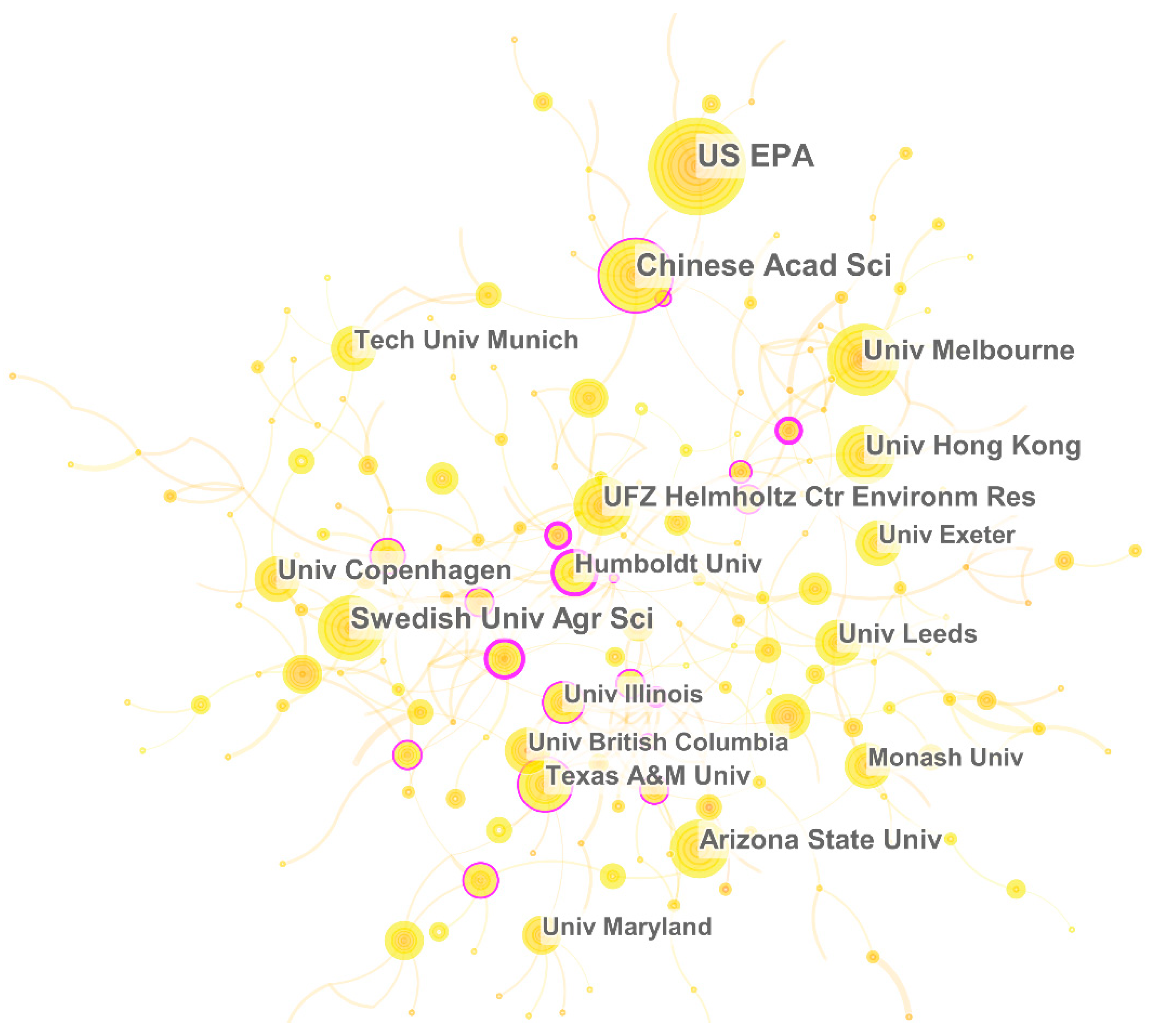
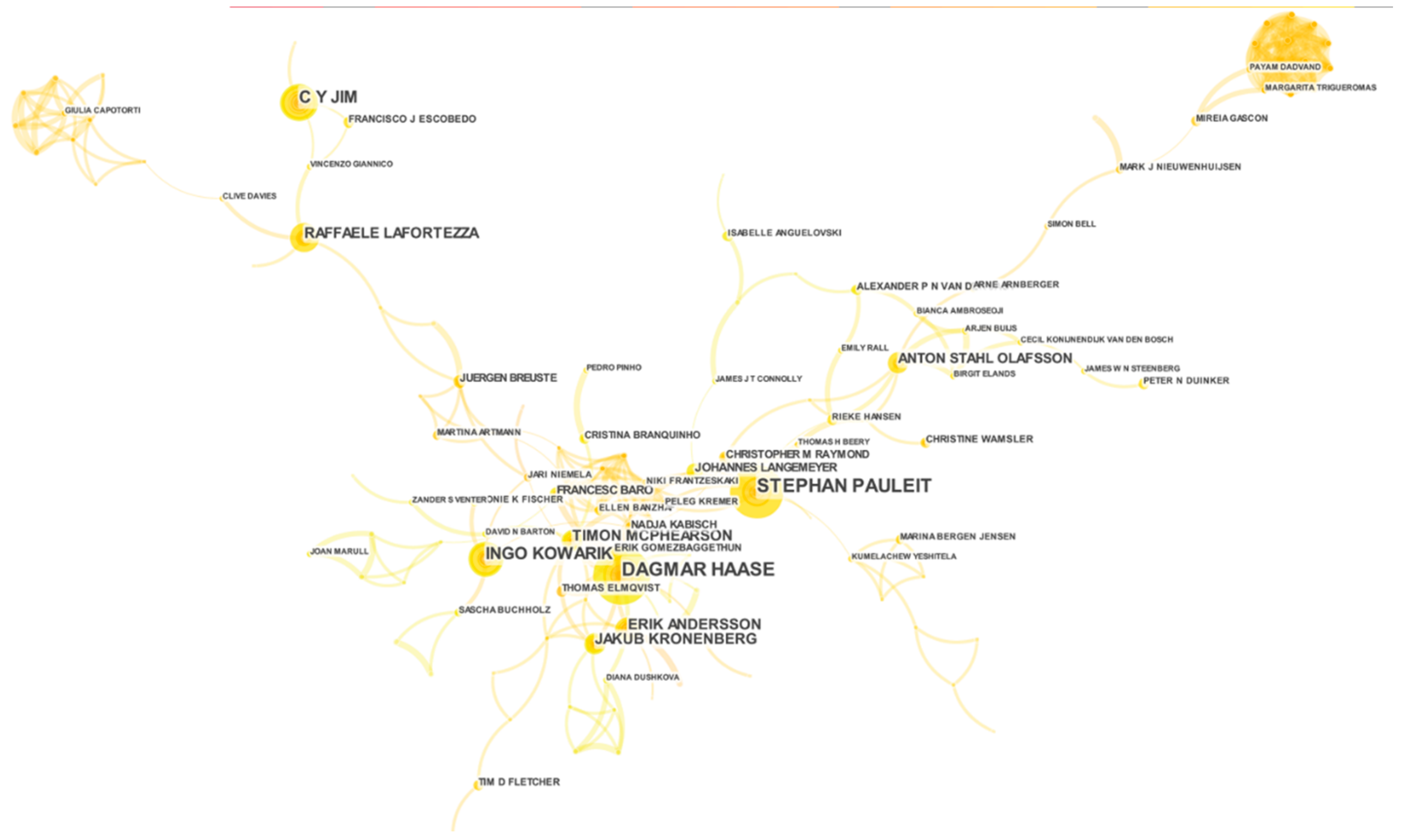
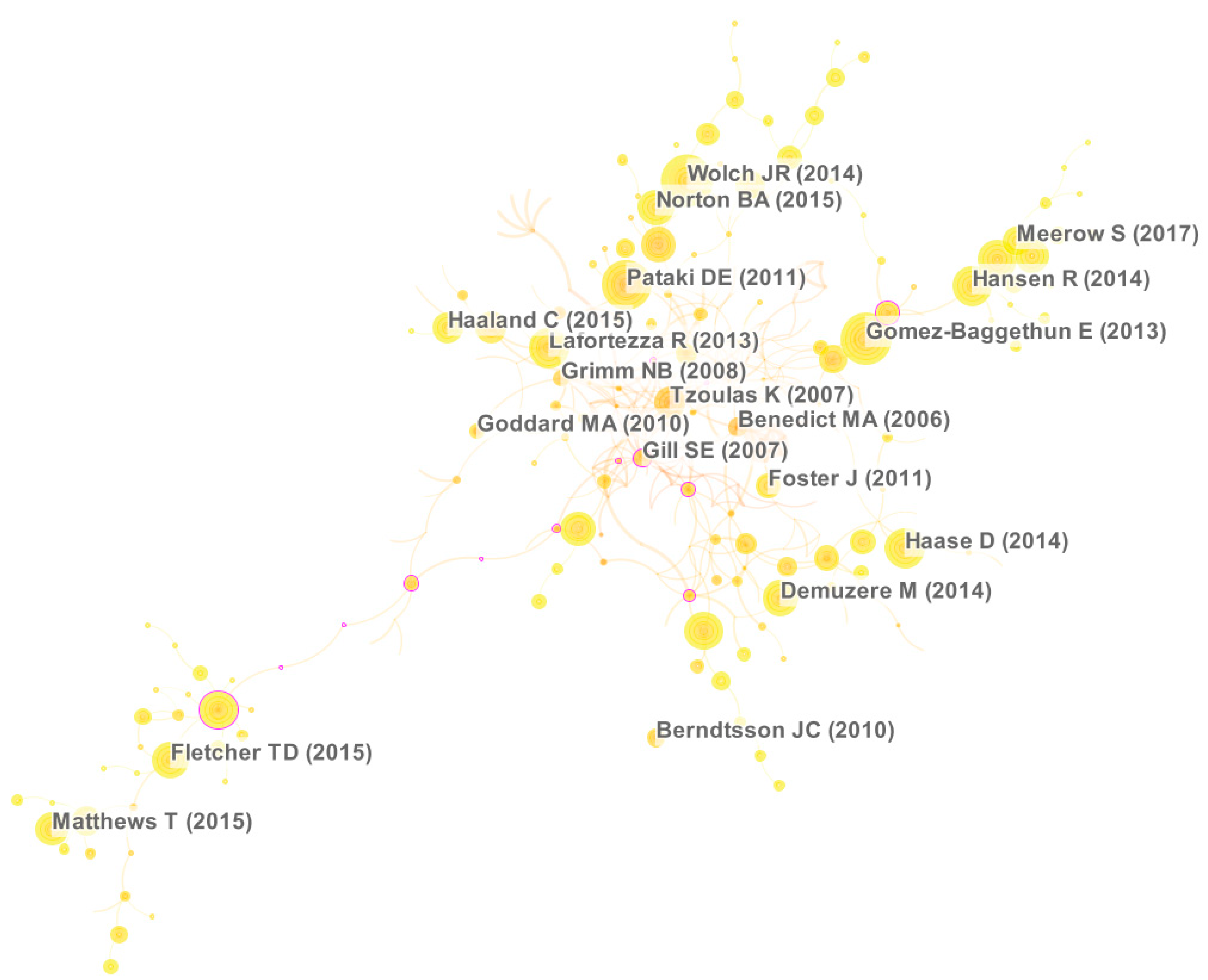
| NO. | Keywords | Frequency | NO. | Keywords | Frequency |
|---|---|---|---|---|---|
| 1 | green infrastructure | 1225 | 16 | landscape | 234 |
| 2 | ecosystem service | 677 | 17 | health | 219 |
| 3 | city | 573 | 18 | conservation | 214 |
| 4 | management | 523 | 19 | environment | 210 |
| 5 | climate change | 456 | 20 | design | 209 |
| 6 | impact | 442 | 21 | space | 207 |
| 7 | infrastructure | 432 | 22 | land use | 205 |
| 8 | sustainability | 384 | 23 | vegetation | 199 |
| 9 | biodiversity | 359 | 24 | energy | 198 |
| 10 | performance | 318 | 25 | area | 193 |
| 11 | system | 300 | 26 | benefit | 190 |
| 12 | model | 282 | 27 | green space | 189 |
| 13 | urban | 262 | 28 | quality | 184 |
| 14 | framework | 251 | 29 | policy | 182 |
| 15 | urbanization | 240 | 30 | green | 180 |
| Journal | PN | % Total PN | IF (2020) | Year * |
|---|---|---|---|---|
| Sustainability | 305 | 5.61 | 2.576 | 2011 |
| Urban Forestry & Urban Greening | 235 | 4.32 | 4.021 | 2009 |
| Landscape and Urban Planning | 152 | 2.80 | 5.441 | 1986 |
| Science of The Total Environment | 124 | 2.28 | 6.551 | 1977 |
| Journal of Cleaner Production | 114 | 2.10 | 7.246 | 2002 |
| Water | 99 | 1.82 | 2.544 | 2009 |
| Land Use Policy | 66 | 1.21 | 3.682 | 1993 |
| Sustainable Cites and Society | 65 | 1.20 | 5.268 | 2011 |
| Urban Ecosystems | 58 | 1.07 | 2.547 | 2011 |
| Journal of Environmental Management | 57 | 1.05 | 5.647 | 1973 |
| Institution | PN | % total PN | Year |
|---|---|---|---|
| US EPA | 84 | 1.55 | 2001/2011 |
| Chinese Acad SCI | 83 | 1.53 | 2005 |
| Swedish Univ Agr SCI | 66 | 1.21 | 2003 |
| Univ Melbourne | 57 | 1.05 | 2008 |
| Arizona State Univ | 54 | 0.99 | 2007 |
| Univ Copenhagen | 52 | 0.96 | 2008 |
| Univ Hong Kong | 47 | 0.86 | 2014 |
| Texas A&M Univ | 46 | 0.85 | 2009 |
| UFZ Helmholtz Ctr Environmental Research | 46 | 0.85 | 2008 |
| Univ British Columbia | 45 | 0.83 | 1995 |
| NO. | Citation Counts | Authors | Title | Journal | Year |
|---|---|---|---|---|---|
| 1 | 213 | Wolch J R, Byrne J, Newell J P. | Landscape and Urban Planning Urban green space, public health, and environmental justice | Landscape and Urban Planning | 2014 |
| 2 | 168 | Gómez-Baggethun E, Barton D N. | Classifying and valuing ecosystem services for urban planning | Ecological Economics | 2013 |
| 3 | 135 | Norton B A, Coutts A M, Livesley S J, et al. | Landscape and Urban Planning for cooler cities: A framework to prioritise green infrastructure to mitigate high temperatures in urban landscapes | Landscape and Urban Planning | 2015 |
| 4 | 132 | Fletcher T D, Shuster W, Hunt W F, et al. | SUDS, LID, BMPs, WSUD and more—The evolution and application of terminology surrounding urban drainage | Urban Water Journal | 2015 |
| 5 | 130 | Angelstam P, Boresjö-Bronge L, Mikusiński G, et al. | Assessing village authenticity with satellite images: a method to identify intact cultural landscapes in Europe | AMBIO: A Journal of the Human Environment | 2003 |
| 6 | 126 | Demuzere M, Orru K, Heidrich O, et al. | Mitigating and adapting to climate change: Multi-functional and multi-scale assessment of green urban infrastructure | Journal of Environmental Management | 2014 |
| 7 | 117 | Meerow S, Newell J P. | Spatial planning for multifunctional green infrastructure: Growing resilience in Detroit | Landscape and Urban Planning | 2017 |
| 8 | 113 | Andersson E, Barthel S, Borgström S, et al. | Reconnecting cities to the biosphere: stewardship of green infrastructure and urban ecosystem services | Ambio | 2014 |
| 9 | 106 | Pataki D E, Carreiro M, Cherrier J, et al. | Coupling biogeochemical cycles in urban environments: ecosystem services, green solutions, and misconceptions | Frontiers in Ecology and the Environment | 2011 |
| 10 | 103 | Lovell S T, Taylor J R. | Supplying urban ecosystem services through multifunctional green infrastructure in the United States | Landscape Ecology | 2013 |
Publisher’s Note: MDPI stays neutral with regard to jurisdictional claims in published maps and institutional affiliations. |
© 2021 by the authors. Licensee MDPI, Basel, Switzerland. This article is an open access article distributed under the terms and conditions of the Creative Commons Attribution (CC BY) license (https://creativecommons.org/licenses/by/4.0/).
Share and Cite
Shao, H.; Kim, G.; Li, Q.; Newman, G. Web of Science-Based Green Infrastructure: A Bibliometric Analysis in CiteSpace. Land 2021, 10, 711. https://doi.org/10.3390/land10070711
Shao H, Kim G, Li Q, Newman G. Web of Science-Based Green Infrastructure: A Bibliometric Analysis in CiteSpace. Land. 2021; 10(7):711. https://doi.org/10.3390/land10070711
Chicago/Turabian StyleShao, Huamei, Gunwoo Kim, Qing Li, and Galen Newman. 2021. "Web of Science-Based Green Infrastructure: A Bibliometric Analysis in CiteSpace" Land 10, no. 7: 711. https://doi.org/10.3390/land10070711
APA StyleShao, H., Kim, G., Li, Q., & Newman, G. (2021). Web of Science-Based Green Infrastructure: A Bibliometric Analysis in CiteSpace. Land, 10(7), 711. https://doi.org/10.3390/land10070711






